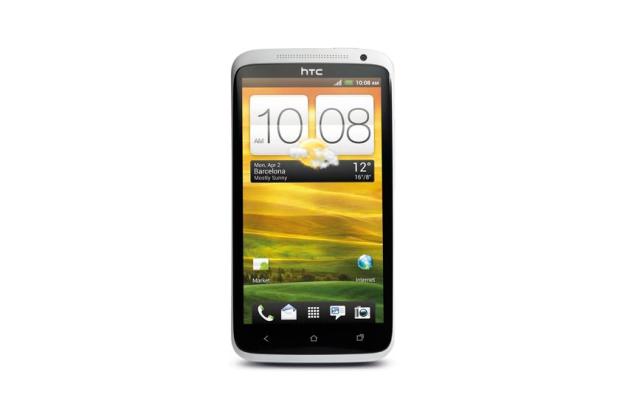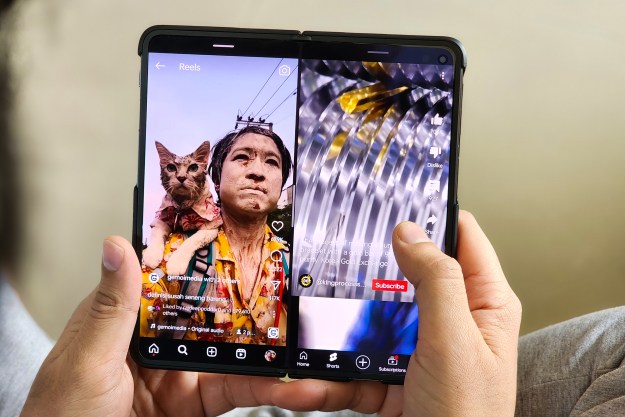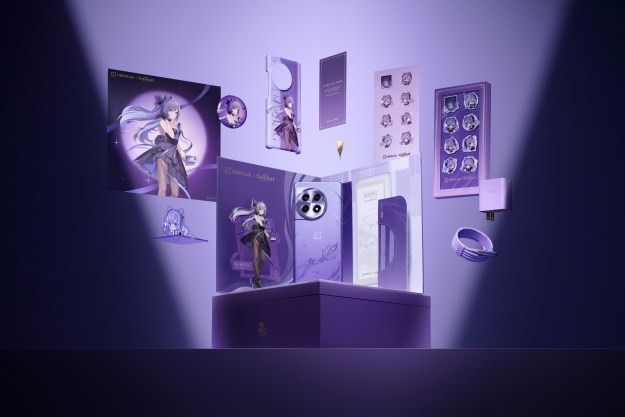
“If you're on AT&T, there is no doubt that this is now the phone to have, and at just $200, it's a lot more affordable than the $300 price we've been seeing for top-notch Android devices.”
- Fantastic, thin design
- Comfortable to hold
- Amazing rear camera
- Runs Android 4.0 (ICS)
- Beats Audio included
- HTC Media Link HD is fun
- Sense 4.0 UI is puzzling
- Non-removable battery
- No microSD
HTC didn’t have a good 2011. It lost its strong footing on almost every carrier to competitors like Samsung, falling in a market that has shown enormous growth. The One series is an attempt to turn things around. With the One S and One X, HTC is on a mission to prove it has the skills to last in this fast-changing market and remain a relevant driving force in phones. Most of all, however, it’s trying to make better phones for you. Has it succeeded? Find out below.
Video overview
Feel
While we personally prefer the One S in terms of overall size, the One X handles its larger size well. Like its smaller brother, it feels like the culmination of more than a year of improvements (and setbacks) in HTC’s phone designs. It borrows the overall design pioneered on devices like the Sensation, but merges them with the sleek unibody design of phones like the Radar. The One X feels even more like a flattened, slimmed down Amaze 4G than the One S, which is quite awesome. The One X and S are the best-designed HTC phones we’ve used, and possibly the most comfortable as well. The X trades a bit of comfort for its wider profile, but its angular edges make it easier to keep a grip while you stretch your fingers to use its larger screen.
While recent phones like the Amaze and Galaxy Nexus seem to be getting bulkier, the One X follows in the footsteps of the Droid Razr. It’s much more comfortable to hold than the Razr, but still one of the thinner phones at just 9.1mm thick – about equal with the iPhone 4S.
The screen size and choice of fixed navigation buttons may also prove wise, as it’s much easier to reach the power, volume, and three haptic navigation buttons (Back, Home, Multitask menu). Having said that, because the screen is so large, it almost feels like space is being wasted. HTC could have included an extra row of icons if it wanted to, especially considering that it ripped out Google’s Search Bar from the top of the screen. There are noticeable gaps between icon rows that are a bit too large.
The One X isn’t a revolutionary leap forward in any major way, but it refines and takes smartphone design up a notch, like the One S.
Screen
With the One S, HTC used AMOLED technology, but with the One X, it has used a slightly upgraded form of LCD it calls “Super” LCD. The results are fairly impressive, though HTC’s marketing efforts seem to hide the fact that the X has an LCD screen (perhaps because AMOLED is more popular right now). For a while, we actually believed the screen used AMOLED technology like the S. For LCD, the phone is capable of getting fairly good blacks and bold colors.
The screen’s 1280 x 720 pixel resolution and LCD screen does eliminate one of the only problems we had with the One S as well: annoying subpixels. On the HTC One S – which has a smaller 4.3-inch AMOLED screen and 960 x 540 pixel resolution – we noticed some slight problems with jagged edges and black subpixels.
Gorilla Glass makes all that screen feel relatively durable, and should help resist scratches and smudges.
Operating system
Like the other One phones, the X runs on Google’s new Android 4.0 (Ice Cream Sandwich) operating system, which means it’s up to date. Most of the key benefits of Android 4.0 remain intact, but HTC has heavily modified the design of the OS with “Sense 4.0,” with the goal of making it look more like its Android 2.3 phones. Some cosmetic changes are fine, but others are a bit puzzling, like the new widget and homescreen modifier, and the new multitasking screen. At times, it feels like HTC is being different just for the sake of it, which is never good.
Still, the good outweighs the bad. Because this runs Android 4.0, users will have many stability improvements. If you can find its new location, the data usage monitoring feature makes a handy way to stay under your data cap, and you’ll notice many other small enhancements, too.
Pre-installed apps
HTC tries to make things easy on new users by including useful apps like weather, a task manager, and other simple things, but it does go overboard. There are about 40 apps installed on the phone when you buy it, many of which aren’t removable or particularly useful. Luckily, the One X has about 20 less pre-installed apps than the One S.
You can download extra HTC software from the HTC Hub, though we don’t recommend it. Stick to the Google Play store for now. We also don’t recommend spending money on HTC Watch, a movie service. There are other solutions out there that are not device and manufacturer specific.
(Warning: When you make new contacts on the HTC One X, make sure save them to Google Contacts, not “Phone.” Your contacts are safer in Google’s cloud than on the phone. You can delete them there anytime as well. HTC is shutting down all of its older cloud backup services on April 30, so if you had a previous HTC phone and used HTC Sense to backup contacts, text messages, or anything else, follow these instructions to get your data before it’s gone forever.)
HTC Media Link accessory
Along with the car stereo clip, HTC is releasing a relatively easy way to connect your smartphone straight up to your TV without the need for any wires. If you buy the $90 HTC Media Link HD, you can mirror your phone’s screen directly to your HDTV with a swipe of your fingers. Using a wireless connection, you plug the Media Link into the wall (Micro USB) and your TV (HDMI). After a quick initial setup, you can simply swipe three fingers up the screen at any time and show your content, whether it be Angry Birds, a video, or pictures, right on your TV. Pretty neat.

Beats Audio rocks
With HTC’s Rezound, to use Beats Audio, you had to use the crappy music player HTC installed on the device. Thankfully, this requirement has been removed. We’ll leave it to you to decide if some audio filtering is really a big deal, but it did make music sound a bit better (though the phone does not come with premium headphones, or any headphones, for that matter). The HTC Music app is also much improved. Instead of just playing music, it now acts as a hub for all of your other music apps, like Amazon MP3, Google Music, Pandora, and Spotify. All of them are easily accessible from the music hub – a step in the right direction. Useful features like this would serve HTC better than some of its other efforts. HTC also sells a Car Stereo Clip that makes it easier to stick the phone in your windshield for navigation and music on the go.
Specs
We’ll keep this brief. The One X has a 1.5GHz dual-core Qualcomm MSM 8960 processor, 1GB of RAM, 16GB of internal flash storage, a 4.7-inch 1280 x 720 pixel Super LCD screen, an 8-megapixel rear camera, and a 1.3-megapixel front camera. It runs on Android 4.0 with HTC’s Sense 4.0 UI overlaid on top. Common features include Bluetooth 4.0, Micro SIM, Micro USB, headphone jack, proximity sensor, digital compass, gyroscope/accelerometer, and Wi-Fi (of course). Sadly, there is no microSD slot.
We tend to weight our own experiences using a device much higher than benchmark scores, but for those interested, in the Quadrant benchmark test, the One X performed incredibly well, scoring an average of about 5,000, which is the highest score we’ve seen other than the One S, which posted near identical results. For reference, the speedy Samsung Galaxy Tab 7.7 scored between 2,500 and 3,400 on the same test. Is the One X twice as fast? It’s hard to say, but it may have a leg up on the competition.
Camera
If there’s “one” thing the One X and S may be known for, it’s their cameras. Using a combination of technologies HTC is dubbing “ImageSense,” the X and S 8-megapixel rear cameras produce superb photos compared to other smartphones, even eclipsing the iPhone 4S in select areas. The X has a fast f/2.0 aperture that supposedly captures about 40 percent more light than other phones, a special imaging chip inside it, a smart flash with five levels of intensity, and HDR (High Dynamic Range), which allows it to take better pictures if there is a bright light behind your subject (if you like sunsets, this is for you).
Sample photos (click to enlarge)
In our testing (check out our camera test from MWC), we’ve found the One S’s camera to be extremely fast and accurate. Indoor shots look at least as good as the iPhone 4S and outdoor shots look amazing as well. In most conditions, it’s still a crapshoot which phone will produce a better shot, but in certain circumstances, HTC does have an edge. Video is now one of them.
One of the most innovative new features of the One series is the ability to snap photos while recording video. Anytime while recording, you can snap a picture of whatever is going on. It’s fantastic. If you’re watching a video, you can take screenshots of what you’re watching as well.
Outside of video mode, holding the shutter button will let you take a burst of photos as well. The default is set to a limit of 20 burst photos, but you can edge it up to 99 if you love taking shots. After you’re done shooting a burst, you can pick and choose which pictures are your favorite or save the whole batch. It’s a quirky feature, but may be very useful in some circumstances.
Voice and data
Voice calls are pretty standard on AT&T’s network. We had no trouble hearing or being heard. As always, voice calls sound crappy. No change here.
On AT&T’s 4G LTE network, we’ve experienced a mix of speeds. We’ve been bumped down to 3G several times, but due to AT&T’s branding, 3G HSPA+ speeds are still labeled as “4G” in the top bar. You only know if you are actually on 4G if there’s a little lit up “LTE” under it. The difference is far too subtle. AT&T, get a clue and stop confusing users. You have a real 4G network now. No need to lie about your old one anymore.
4G labeling aside, we’ve been getting about 8.5 megabits per second (Mbps) download speeds and 1.2Mbps on the upload, as an average.
Battery life
Battery life on the One X is better than the One S, as best we can tell. On moderate usage, we were able to get almost two days out of the 1,800mAh battery, which is better than a lot of comparable phones. HTC is claiming the device gets 8.3 hours of talk time and 13 days of standby – in the phone’s defense, it seems to also perform quite well on standby. If you watch a lot of moving video though, the phone may not perform as well. Since it does have a larger screen, video definitely isn’t its friend.
For those who need more battery life at times, this may not be your phone. The battery is sealed inside the phone, so there’s no way to manually swap batteries in a crunch.
As it stands, the battery life exceeds the Galaxy Nexus, but comes nowhere close to the performance of the Droid Razr Maxx, which still remains our favorite phone when it comes to battery life. GSM Arena has a good benchmark of how well the One S’s battery life stacks up. We believe the One X should get similar results. Give it a look if you’re interested.
Compared to One S
We’ve been comparing the One X to the One S during this entire review, but in summary, we like the size (4.3-inch screen) and design of the One S slightly more, but the One X compensates for its larger 4.7-inch screen with a better front-facing camera (1.3MP vs 0.3MP), a crisper screen (1280 x 720 pixels), a 4G LTE connection thanks to AT&T, and a battery that has lasted a bit longer for us (though we haven’t performed rigid battery life tests). Both phones are at the top of their game and both are almost identical in most ways. The One S can also use the HTC Media Link HD.
Overall
The One X is as large as mainstream phones should be. To some of you, it will definitely be too large to comfortably hold. We’ve managed to get used to it and it isn’t any harder to hold than the Galaxy Nexus, so we aren’t going to punish it, but if you’re looking for a more reasonable size, the One S on T-Mobile is almost the same phone, but a bit smaller. We really like the direction HTC is going with its One series. Everything about this phone is top of the line, from its battery life to its 4G LTE connection, camera, and construction (polycarbonate). If you’re on AT&T, there is no doubt that this is now the phone to have, and at just $200, it’s a lot more affordable than the $300 price we’ve been seeing for top-notch Android devices.
Highs
- Fantastic, thin design
- Comfortable to hold
- Amazing rear camera
- Runs Android 4.0 (ICS)
- Beats Audio included
- HTC Media Link HD is fun
Lows
- Sense 4.0 UI is puzzling
- Non-removable battery
- No microSD
Update: If you haven’t read our huge, in-depth comparison between the HTC One X and Galaxy S3, check it out.
Editors' Recommendations
- OnePlus surprises us with dazzling Android tablet and smartwatch
- OnePlus just fixed a big issue with the OnePlus Watch 2
- Have a Samsung Galaxy S23? Don’t update your phone to One UI 6.1
- Does the OnePlus 12 have a curved screen?
- Is the OnePlus Watch 2 waterproof?











